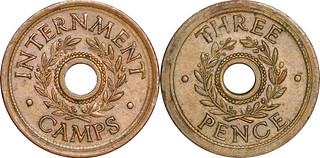
PREV ARTICLE
FULL ISSUE
PREV FULL ISSUE
FEATURED WEB PAGE: AUSTRALIA WWII INTERNMENT TOKENSThis week's Featured Web Site is about Australia's WWII Internment Tokens.With increasing concerns as the pall of WWII settled over Europe, “enemy aliens” in Australia whose loyalty was suspect were removed to Internment Camps. The Camps initially housed immigrants from Germany, Italy and other axis-linked countries. They were subsequently joined by Japanese internees, and prisoners of war and internees transported from the Middle East, Pacific Islands, the Netherlands East Indies, the Straits Settlements, the United Kingdom and New Zealand. For security reasons, tokens were used in Australian and New Zealand World War II Internment Camps in place of the normal currency. They were introduced in Australia, probably in 1943, to replace paper canteen coupons. Two Melbourne firms manufactured the tokens: Arendsen & Sons made five shillings, two shillings and one penny pieces; while KG Luke & Co produced the one shilling and three pence tokens that completed the series. Other than the pennies, which were struck in brass (with a few rare copper or bronze trial or specimen strikes), the tokens were struck in copperi. The tokens were holed in the centre, clearly distinguishing them from the circulating currency. Wreaths, ornamented with berries and gum nuts, surround the centre holes together with the inscriptions of “INTERNMENT CAMPS” on the obverse and the denomination on the reverse. The Luke tokens have finer design details than the Arendsen pieces.  www.sterlingcurrency.com.au/research/
|
